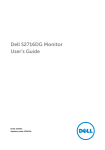Download Dell SP2008WFPF User's Manual
Transcript
Dell™ SP2008WFP Flat Panel Monitor About Your Monitor Front View Back View Side View Bottom View Monitor Specifications Cleaning Your Monitor Using Your Monitor Stand Attaching the Stand Organizing Your Cables Using the Tilt Removing the Stand Solving Problems Troubleshooting Your Monitor General Problems Product Specific Problems USB Problems Troubleshooting Your Soundbar Appendix Safety Instruction FCC Notice (U.S. Only) and Other Regulatory Information Contacting Dell Setting Up Your Monitor Connecting Your Monitor Installing the Webcam Application Using the Front Panel Using the OSD Setting the Optimal Resolution Using the Dell Soundbar (Optional) Notes, Notices, and Cautions NOTE: A NOTE indicates important information that helps you make better use of your computer. NOTICE: A NOTICE indicates either potential damage to hardware or loss of data and tells you how to avoid the problem. CAUTION: A CAUTION indicates a potential for property damage, personal injury, or death. Information in this document is subject to change without notice. © 2007 Dell Inc. All rights reserved. Reproduction in any manner whatsoever without the written permission of Dell Inc. is strictly forbidden. Trademarks used in this text: Dell, the DELL logo, Inspiron, Dell Precision, Dimension, OptiPlex, Latitude, PowerEdge, PowerVault, PowerApp, and Dell OpenManage are trademarks of Dell Inc; Microsoft, Windows, and Windows NT are registered trademarks of Microsoft Corporation; Adobe is a trademark of Adobe Systems Incorporated, which may be registered in certain jurisdictions. ENERGY STAR is a registered trademark of the U.S. Environmental Protection Agency. As an ENERGY STAR partner, Dell Inc. has determined that this product meets the ENERGY STAR guidelines for energy efficiency. Other trademarks and trade names may be used in this document to refer to either the entities claiming the marks and names or their products. Dell Inc. disclaims any proprietary interest in trademarks and trade names other than its own. Model SP2008WFP June 2007 Rev. A00 Back to Contents Page About Your Monitor Dell™ SP2008WFP Flat Panel Monitor Front View Back View Bottom View Side View Monitor Specifications Cleaning Your Monitor Front View 1. Video input select 2. OSD menu / select button 3. Brightness & Contrast / Down (-) button 4. Auto-Adjust / Up (+) button 5. Power button (with power light indicator) 6. Webcam 7. MIC Back View 1 VESA mounting holes (100mm) (Behind attached base plate) Use to mount the monitor. 2 Barcode serial number label Refer to this label if you need to contact Dell for technical support. 3 Security lock slot Use a security lock with the slot to help secure your monitor. 4 Dell Soundbar mounting brackets Attach the optional Dell Soundbar. 5 Regulatory rating label List the regulatory approvals. 6 Stand removal button Press to release the stand. 7 Cable management hole Help organize cables by placing them through the hole. Bottom View 1 Power connector Insert the power cable. 2 Dell Soundbar power connector Connect the power cord for the Soundbar (optional). 3 DVI connector Connect your computer DVI cable. 4 VGA connector Connect your computer VGA cable. 5 USB upstream connector Connect the USB cable that came with your monitor to the monitor and the computer. Once this cable is connected you can use the USB connectors on the side and bottom of the monitor. 6 USB connector Connect your USB devices. NOTE: You can use this connector only after you connect the USB cable to the computer and the USB upstream connector on the monitor. Side View USB connectors (downstream) Left side Right side Monitor Specifications Power Management Modes If you have VESA's DPM™ compliance display card or software installed in your PC, the monitor automatically reduces its power consumption when not in use. This is referred to as Power Save Mode. The monitor automatically resumes functioning when the computer detects input from the keyboard, mouse, or other input devices. The following table shows the power consumption and signaling of this automatic power saving feature: VESA Modes Horizontal Sync Vertical Sync Video Power Indicator Power Consumption Normal operation (with Dell Soundbar and USB active) Active Active Active Blue 75 W (maximum) Normal operation Active Active Active Blue 38 W (typical) Active-off mode Inactive Inactive Blanked Amber Switch off - - - Off Less than 2 W Less than 1 W NOTE: The OSD only functions in the normal operation mode. One of the following messages appears when the “menu” or “plus” buttons are pressed when in Active-off mode. 1. Auto Detect (Analog Input) In Power Save Mode Press Computer Power Button or Any Key on Keyboard or Move Mouse 1. Auto Detect (Digital Input) In Power Save Mode Press Computer Power Button or Any Key on Keyboard or Move Mouse or 2. Analog Input In Power Save Mode Press Computer Power Button or Any Key on Keyboard or Move Mouse or 3. Digital Input In Power Save Mode Press Computer Power Button or Any Key on Keyboard or Move Mouse Activate the computer and the monitor to gain access to the OSD. This monitor is ENERGY STAR®-compliant as well as TCO '99 power management compatible. * Zero power consumption in OFF mode can only be achieved by disconnecting the main cable from the monitor. Pin Assignments 15-pin D-Sub Connector The following table shows pin assignments in the D-Sub connector: Pin Number Monitor Side of the 15-pin Side Signal Cable 1 Video-Red 2 Video-Green 3 Video-Blue 4 GND 5 Self-Test 6 GND-R 7 GND-G 8 GND-B 9 DDC +5V 10 GND 11 GND 12 DDC data 13 H-sync 14 V-sync 15 DDC clock 24-pin Digital-only DVI Connector NOTE: Pin 1 is at the top right. The following table shows pin assignments in the DVI connector: Pin Signal Assignment Pin Signal Assignment Pin Signal Assignment 1 T.M.D.S. Data 2- 9 T.M.D.S. Data 1- 17 T.M.D.S. Data 0- 2 T.M.D.S. Data 2+ 10 T.M.D.S. Data 1+ 18 T.M.D.S. Data 0+ 3 T.M.D.S. Data 2 Shield 11 T.M.D.S. Data 1 Shield 19 T.M.D.S. Data 0 Shield 4 No Connect 12 No Connect 20 No Connect 5 No Connect 13 No Connect 21 No Connect 6 DDC Clock 14 +5V Power 22 T.M.D.S. Clock Shield 7 DDC Data 15 Self-Test 23 T.M.D.S. Clock + 8 No Connect 16 Hot Plug Detect 24 T.M.D.S. Clock - Universal Serial Bus (USB) Interface This monitor supports High-Speed Certified USB 2.0 interface. Data Rate Power Consumption High speed 480 Mbps 2.5W (Max., each port) Full speed 12 Mbps Low speed 1.5 Mbps USB ports: 2.5W (Max., each port) 2.5W (Max., each port) l l 1 upstream - rear 4 downstream - 2 on rear; 2 on left side NOTE: USB 2.0 capability requires 2.0-capable computer. NOTE: The USB interface of the monitor works ONLY when monitor is powered ON (or in Power Save Mode). Switching your monitor OFF and then ON would re-enumerate its USB interface; attached peripherals may take a few seconds to resume normal functionality. Plug and Play Capability You can install the monitor in any Plug and Play-compatible system. The monitor automatically provides the computer system with its Extended Display Identification Data (EDID) using Display Data Channel (DDC) protocols so the system can configure itself and optimize the monitor settings. Most monitor installations are automatic; you can select different settings, if desired. General Model number SP2008WFP Flat Panel Screen type Active matrix - TFT LCD Screen dimensions 20.1 inches (20.1-inch viewable image size) Preset display area: Horizontal 433.44 mm (17.06 inches) Vertical 270.9 mm (10.67 inches) Pixel pitch 0.258 mm Viewing angle 160° (vertical) typ, 160° (horizontal) typ Luminance output 300 CD/m ²(typ) Dynamic contrast ratio 2000 to 1 (typ) Faceplate coating ARC-Glare (2H) Backlight CCFL (4) edgelight system Response Time 2ms typical (Grey to Grey) Webcam - MIC Specifications Lens Field of view 66.5 degree +/- 5 % Focus mode Fixed Focus Focus area 49cm~Infinity Focusing 1100 mm distance (normal mode) Image Sensor Active array size 2.0 mega-pixel Video specification Video frame rate 1600 x 1200 (UXGA) - up to 10 frames per second 640 x 480 (VGA) and below - up to 30 frames per second Audio Specification Image flip Horizontally Digital zoom 2x Microphone type Dual Microphone Interface USB 2.0 high Speed Power Supply 5.0 volts+- 5% Webcam - MIC System Requirements The following are the minimum system requirements for Webcam - MIC feature: Intel® Pentium® 4 or AMD® equivalent processor running at 1.8 GHz or higher (Recommended: Intel Pentium 4, 2.8 GHz with Hyper-Threading enabled) Microsoft® Windows® XP Service Pack 2 or Windows Vista 256 MB RAM (512 MB RAM or higher recommended) 580 MB free hard disk space Available USB 1.1 port or a USB 1.1 hub with external power supply (USB 2.0 required for maximum frame rate and resolution) CD-ROM/DVD-ROM drive for software installation Monitor Resolution Horizontal scan range 30 kHz to 83 kHz (automatic) Vertical scan range 56 Hz to 76 Hz (automatic) Optimal preset resolution 1680 x 1050 at 60 Hz Highest preset resolution 1680 x 1050 at 60 Hz Video Supported Modes Video display capabilities (DVI HD playback) 480i/480p/576i/576p/720p/1080i/1080p (Supports HDCP) Preset Display Modes For quick adjustments of different modes, the monitor has default setting modes as shown in the following table: Display Mode Horizontal Frequency (kHz) Vertical Frequency (Hz) Pixel Clock (MHz) Sync Polarity (Horizontal/Vertical) VESA, 720 x 400 31.5 70.0 28.3 -/+ VESA, 640 x 480 31.5 60.0 25.2 -/- VESA, 640 x 480 37.5 75.0 31.5 -/- VESA, 800 x 600 37.9 60.0 40.0 +/+ VESA, 800 x 600 46.9 75.0 49.5 +/+ VESA, 1024 x 768 48.4 60.0 65.0 -/- VESA, 1024 x 768 60.0 75.0 78.8 +/+ VESA, 1152 x 864 67.5 75.0 108 +/+ VESA, 1280 x 1024 64.0 60.0 108 +/+ VESA, 1280 x 1024 80.0 75.0 135.0 +/+ VESA 1680 x 1050 65.3 60 146.3 -/+ VESA, 1680 x 1050 64.7 59.9 119 +/- Electrical Video input signals Analog RGB, 0.7 Volts +/-5%, positive polarity at 75 ohm input impedance Digital DVI-D TMDS, 600mV for each differential line, positive polarity at 50 ohm input impedance Synchronization input signals Separate horizontal and vertical synchronizations, polarity-free TTL level, SOG (Composite SYNC on green) AC input voltage / frequency / current 100 to 240 VAC / 50 or 60 Hz + 3 Hz / 1.5A Inrush current 120V:30A (Max.) 240V:60A (Max.) Physical Characteristics The following table shows the physical characteristics of monitor: Connector type 15-pin D-subminiature, blue connector; DVI-D, white connector Signal cable type Digital: Detachable, DVI-D, Solid pins, shipped detached from the monitor Analog: Detachable, D-Sub, 15pins, shipped attached to the monitor Dimensions (with stand): Height 15.39 inches (390.98 mm) Width 18.62 inches (473.05 mm) Depth 5.80 inches (147.36 mm) Dimensions: (without stand) Height Width Depth Stand dimensions: Height Width Depth 12.56 inches (319.2 mm) 18.62 inches (473.05 mm) 2.59 inches (65.9 mm) 11.69 inches (297.03 mm) 10.42 inches (264.84 mm) 5.8 inches (147.36 mm) Weight with packaging 17.73 lbs (8.05 kg) Weight with stand assembly and cables 15.49 lbs (7.03 kg) Weight without stand assembly (For wall mount or VESA mount considerations - no cables) 11.45 lbs (5.20 kg) Weight of stand assembly 2.89 lbs (1.31 kg) Environmental Refer to the operation conditions given below to use the monitor correctly. Temperature: Operating 5° to 35°C (41° to 95°F) Nonoperating Storage: -20° to 60°C (-4° to 140°F) Shipping: -20° to 60°C(-4° to 140°F) Humidity: Operating 10% to 80% (noncondensing) Nonoperating Storage: 5% to 90% (noncondensing) Shipping: 5% to 90%(noncondensing) Altitude: Operating 3,657.6m (12,000 ft) max Nonoperating 12,192 m (40,000 ft) max Thermal dissipation 256.08 BTU/hour (maximum) 129.75 BTU/hour (typical) Cleaning Your Monitor CAUTION: Read and follow the safety instructions before cleaning the monitor. CAUTION: Before cleaning the monitor, unplug the monitor power cable from the electrical outlet. l l l l l To clean your antistatic screen, slightly dampen a soft, clean cloth with water. If possible, use a special screen-cleaning tissue or solution suitable for the antistatic coating. Do not use benzene, thinner, ammonia, abrasive cleaners, or compressed air. Use a slightly-dampened, warm cloth to clean the plastics. Avoid using detergent of any kind as some detergents leave a milky film on the plastics. If you notice a white powder when you unpack your monitor, wipe it off with a cloth. This white powder occurs during the shipping of the monitor. Handle your monitor with care as darker-colored monitor may scratch and show white scuff marks more than lighter-colored monitor. To help maintain the best image quality on your monitor, use a dynamically changing screen saver and power off your monitor when not in use. Back to Contents Page Back to Contents Page Appendix Dell™ SP2008WFP Flat Panel Monitor Safety Instructions FCC Notice (U.S. Only) and Other Regulatory Information Contacting Dell CAUTION: Safety Instructions CAUTION: Use of controls, adjustments, or procedures other than those specified in this documentation may result in exposure to shock, electrical hazards, and/or mechanical hazards. For safety instructions, see the Product Information Guide. FCC Notice (U.S. Only) and Other Regulatory Information For FCC Notice and other regulatory information, see the regulatory compliance website located at www.dell.com/regulatory_compliance. Contacting Dell For customers in the United States, call 800-W W W-DELL (800-999-3355). NOTE: If you do not have an active Internet connection, you can find contact information on your purchase invoice, packing slip, bill, or Dell product catalog. Dell provides several online and telephone-based support and service options. Availability varies by country and product, and some services may not be available in your area. To contact Dell for sales, technical support, or customer service issues: 1. Visit support.dell.com. 2. Verify your country or region in the Choose A Country/Region drop-down menu at the bottom of the page. 3. Click Contact Us on the left side of the page. 4. Select the appropriate service or support link based on your need. 5. Choose the method of contacting Dell that is convenient for you. Back to Contents Page Back to Contents Page Setting Up Your Monitor Dell™ SP2008WFP Flat Panel Monitor If you have a Dell™ desktop or a Dell™ portable computer with internet access 1. Go to http://support.dell.com, enter your service tag, and download the latest driver for your graphics card. 2. After installing the drivers for your Graphics Adapter, attempt to set the resolution to 1680x1050 again. NOTE: If you are unable to set the resolution to 1680x1050, please contact Dell™ to inquire about a Graphics Adapter that supports these resolutions. Back to Contents Page Back to Contents Page Setting Up Your Monitor Dell™ SP2008WFP Flat Panel Monitor If you have non Dell™ desktop, portable computer, or graphic card 1. Right-click on the desktop and click Properties. 2. Select the Settings tab. 3. Select Advanced. 4. Identify your graphics controller supplier from the description at the top of the window (e.g. NVIDIA, ATI, Intel etc.). 5. Please refer to the graphic card provider website for updated driver (for example, http://www.ATI.com OR http://www.NVIDIA.com ). 6. After installing the drivers for your Graphics Adapter, attempt to set the resolution to 1680x1050 again. NOTE: If you are unable to set the resolution to 1680x1050, please contact the manufacturer of your computer or consider purchasing a graphics adapter that will support the video resolution of 1680x1050. Back to Contents Page Back to Contents Page Setting Up Your Monitor Dell™ SP2008WFP Flat Panel Monitor Important instructions to set the display resolution to 1680X1050 (Optimal) For optimal display performance while using the Microsoft Windows® operating systems, set the display resolution to 1680 x 1050 pixels by performing the following steps: 1. Right-click on the desktop and click Properties. 2. Select the Settings tab. 3. Move the slider-bar to the right by pressing and holding left-mouse button and adjust the screen resolution to 1680X1050. 4. Click OK. If you do not see 1680X1050 as an option, you may need to update your graphics driver. Please choose the scenario below that best describes the computer system you are using, and follow the provided directions: 1: If you have a Dell™ desktop or a Dell™ portable computer with internet access. 2: If you have non Dell™ desktop, portable computer, or graphic card. Back to Contents Page Dell™ SP2008WFP Flat Panel Monitor User Guide Important instructions to set the display resolution to 1680X1050 (Optimal) Information in this document is subject to change without notice. © 2007 Dell Inc. All rights reserved. Reproduction in any manner whatsoever without the written permission of Dell Inc. is strictly forbidden. Trademarks used in this text: Dell, the DELL logo, Inspiron, Dell Precision, Dimension, OptiPlex, Latitude, PowerEdge, PowerVault, PowerApp, and Dell OpenManage are trademarks of Dell Inc; Microsoft, Windows, and Windows NT are registered trademarks of Microsoft Corporation; Adobe is a trademark of Adobe Systems Incorporated, which may be registered in certain jurisdictions. ENERGY STAR is a registered trademark of the U.S. Environmental Protection Agency. As an ENERGY STAR partner, Dell Inc. has determined that this product meets the ENERGY STAR guidelines for energy efficiency. Other trademarks and trade names may be used in this document to refer to either the entities claiming the marks and names or their products. Dell Inc. disclaims any proprietary interest in trademarks and trade names other than its own. Model SP2008WFP June 2007 Rev. A00 Back to Contents Page Setting Up Your Monitor Dell™ SP2008WFP Flat Panel Monitor Connecting Your Monitor Installing the Webcam Application Using the Front Panel Using the OSD Menu Setting the Optimal Resolution Using the Dell Soundbar (Optional) Connecting Your Monitor CAUTION: Before you begin any of the procedures in this section, follow the safety instructions. OR 1. Turn off your computer and disconnect the power cable. 2. Connect either the white DVI or the blue VGA cable to the connectors on the computer and the monitor. 3. Connect the USB cable that was included with your monitor to the computer and the upstream USB connector on the monitor. Once this cable is connected to the computer and the monitor, you can use the USB connectors on the monitor. 4. Connect any USB devices. 5. Connect the power cables. 6. Turn on your monitor and computer. If you do not see an image, push the input select button and ensure the correct input source is selected. If you still do not see an image, see Troubleshooting your monitor. Installing the Webcam Application (Microsoft® Windows® Operating Systems) The setup.exe application tool launcher provided in the CD allows you to the install Webcam Application on the computer. 1. Insert the Webcam resource media into the CD drive. NOTE: Ensure that the USB cable is connected between the monitor and the computer. 2. The Install Shield Wizard automatically launches the setup application. Choose your desired Language and click Next to continue. 3. Read Software License Agreement and click Yes to continue. 4. Click Browse to change the destination folder where the software will be installed to and click Next to continue. 5. Select Full Installation, click Next and follow the instructions to complete the installation. Click Finish to restart the computer after installation is completed. Alternatively, choose Custom Installation to customize the installation. You are now ready to use the Webcam. The Webcam application provides the following functions. l l l l l Dell Webcam Center: Dell Webcam Center makes it easy to capture photos and video with your Dell Webcam. With Webcam Center, you can perform photo and video captures, or perform advanced tasks such as remote monitoring, motion detection, and time lapse video capturing. Dell Webcam Manager: Dell Webcam Manager is a central access point for all your webcam-related applications. Locate and launch your favorite webcam applications quickly and easily from Webcam Manager while you use your webcam. Dell Webcam Console: The Dell Webcam Console provides a customized set of attractive features, such as Advanced Video and Audio Effects, face tracking and parental control, and enhancing your video chatting experience. Live! Cam Avatar: Live! Cam Avatar lets you disguise yourself as a superstar, a furry friend, or any customized animated character while you video chat using any instant messaging software. The avatar tracks your head movement and lip sync anything you say instantly at the same time. Live! Cam Avatar Creator: Live! Cam Avatar allows you to create your very own personalized avatar from digital photos you have chosen, accompanied by the advanced speech technology which provides lip sync to your animated avatar. Using the Front Panel Use the buttons on the front of the monitor to adjust the image settings. The following table describes the front panel buttons: Use the Input Select button to choose between two different video signals that may be connected to your monitor. Video input select If both VGA and DVI cables are connected to one PC, the monitor displays an image automatically as long as a video signal is present in either the VGA or DVI outputs. When connecting one display to two PCs, if using screen savers, best to set both to the exact times. Whichever mouse is moved first will activate that video input first. NOTE: The floating 'Dell Self-test Feature Check' dialog appears on a black background if the monitor cannot sense a video signal. Using the input select button, select the desired input to be tested either Analog Input or Digital Input. Disconnect the video cable from the video card and the Dell Self-test Feature Check dialogue box will appear if the display is operating correctly. or or The Menu button is used to open and exit the on-screen display (OSD), and exit from menus and sub-menus. See Using the OSD Menu. OSD menu / select Use these buttons to adjust (decrease/increase ranges) items in the OSD menu. Down (-) and Up (+) Use this button to launch Brightness menu. Brightness Menu Use this button to activate automatic setup and adjustment. The following dialog appears on a black screen as the monitor self-adjusts to the current input: Auto Adjust In Progress Auto Adjust Auto Adjustment button allows the monitor to self-adjust to the incoming video signal. After using Auto Adjustment, you can further tune your monitor by using the Pixel Clock (Coarse), Phase (Fine) controls in the OSD. NOTE: Auto Adjust does not occur if you press the button while there are no active video input signals or attached cables. Use the power button to turn the monitor on and off. The blue light indicates the monitor is on and fully functional. An amber light indicates power save mode. Power Button and Indicator Using the OSD Menu NOTE: If you change the settings and then either proceed to another menu, or exit the OSD menu, the monitor automatically saves those changes. The changes are also saved if you change the settings and then wait for the OSD menu to disappear. 1. Press the Menu button to open the OSD menu and display the main menu. Main Menu for Auto Detect Analog (VGA) Input Main Menu for Auto Detect Digital (DVI) Input or Main Menu for Analog (VGA) Input Main Menu for Digital (DVI) Input or NOTE: Auto Adjust, Positioning and Image Settings are only available when you are using the analog (VGA) connector. 2. 3. 4. 5. 6. Icon Press the - and + buttons to move between the setting options. As you move from one icon to another, the option name is highlighted. See the table below for a complete list of all the options available for the monitor. Press the Menu button once to activate the highlighted option. Press - and + button to select the desired parameter. Press Menu to enter the slide bar and then use the - and + buttons, according to the indicators on the menu, to make your changes. Press the Menu button once to return to the main menu to select another option or Press the Menu button two or three times to exit from the OSD menu. Menu and Submenus Description Exit Select to exit the Main menu. Brightness/ Contrast Brightness adjusts the luminance of the backlight. Adjust Brightness first, then adjust Contrast only if further adjustment is necessary. Push the + button to increase luminance and push the - button to decrease luminance (min 0 ~ max 100). Contrast adjusts the degree of difference between darkness and lightness on the monitor screen. Push the + button to increase the contrast and push the - button to decrease the contrast (min 0 ~ max 100). Auto Adjust Even though your computer recognizes your monitor on startup, the Auto Adjustment function optimizes the display settings for use with your particular setup. Select to activate automatic setup and adjustment. The following dialog appears on a black screen as the monitor self-adjusts to the current input: Auto Adjust In Progress Auto Adjustment allows the monitor to self-adjust to the incoming video signal. After using Auto Adjustment, you can further tune your monitor by using the Pixel Clock (Coarse) and Phase (Fine) controls under Image Settings. NOTE: In most cases, Auto Adjust produces the best image for your configuration. NOTE: When using DVI, Auto Adjust is not available. Positioning: Horizontal Vertical Positioning moves the viewing area around on the monitor screen. When making changes to either the Horizontal or Vertical settings, no changes occur to the size of the viewing area. The image shifts in response to your selection. When making changes to Zoom setting, you can increase or decrease the size of image. The image scale changes in response to your selection. Minimum is 0 (-) and maximum is 100 (+). NOTE: When using DVI source, the Horizontal and Vertical settings are not available. Image settings: Pixel Clock (Coarse) Phase (Fine) The Phase, Pixel Clock and Sharpness adjustments allow you to more closely adjust your monitor to your preference. Select Image Settings in the main OSD menu to access these settings. NOTE: Pixel Clock controls the number of pixels scanned by one horizontal sweep. If the frequency is not correct, the screen shows vertical stripes and the images is not proportional. Use the - and + buttons to make adjustments. (Minimum: 0 ~ Maximum: 100) If satisfactory results are not obtained using the Phase adjustment, use Pixel Clock (Coarse) and then use Phase (fine), again. NOTE: This function may change the width of the display image. Use the Horizontal function of the Position menu to center the display image on the screen. Sharpness Scaling Ratio Color Settings Normal Preset Multimedia Preset Gaming Preset Red Preset Blue Preset User Preset The Sharpness adjustment allow you to improve the sharpness of texts. There are five levels for adjustment totally. (0, 25, 50, 75, 100) The Scaling Ratio adjustment allow you to change the image scale with various default settings. NOTE: When using DVI source, the Pixel Clock, Phase and Sharpness settings are not available. NOTE: Scaling Ratio is not available if the resolution of video signal is greater than 1680x1050. However, 16:9 and Fill will be available for video timing. Color Settings adjust the color temperature. Color Settings has the following options: Color Management : You can choose to enable or disable this option. Color Settings Mode : You can choose between a Graphics and a Video mode. If your computer is connected to your monitor, choose Graphics. If a DVD, STB, or VCR is connected to your monitor, choose Video. Color Presets: You can choose different color presets for different viewing modes. l l l l l l In the Graphics mode, you can choose Normal Preset, Multimedia Preset, Gaming Preset, Red Preset, Blue Preset or User Preset; Normal Preset is selected to obtain the default (factory) color settings. This setting is also the “sRGB” standard default color space. Select Multimedia Preset to view media applications. Select Gaming Preset for playing games in your computer. Select Red Preset for a reddish tint. This color setting is used for color-intensive applications (photograph image editing, multimedia, movies, etc.). Select Blue Preset for a bluish tint. This color setting is used for text based applications (spreadsheets, programming, text editors, etc.. User Preset: Use the plus and minus buttons to increase or decrease each of the three colors (R, G, B) independently, in single increments, from 0 to 100. Theatre Preset Sports Preset Nature Preset Hue Saturation NOTE: Optimized color settings such as Multimedia and Gaming presets are unavailable when you disable Color Management selection. l l l l In Video mode, you can choose Theatre, Sports or Nature Preset; Select Theater Preset for playing a movie. Select Sports Preset for viewing sports. Select Nature Preset for general viewing. You can adjust the Hue/Saturation based on the preference. makes video image shade into greenish. makes video image shade into purplish. makes video image look more monochrome. makes video image look more colorful. Advanced Settings Input Color Format Dynamic Contrast Response Time NOTE: Optimized color settings such as Theatre, Sports and Nature presets are unavailable when you disable Color Management selection. Choose the RGB option if monitor is connected to a PC or a DVD using a VGA or a DVI cable. Choose the YPbPr+ option if monitor is connected to a DVD by a YPbPr cable Dynamic Contrast - The feature helps get a higher contrast if you choose Gaming preset, Theatre Preset, Sports Preset and Nature Preset, but brightness is not available for user adjustment in above mode. Response Time - This function improves the response time in Multimedia preset, gaming preset, sports preset and theatre presets. On-Enable the enhancement pattern for response time. Off-Disable the enhancement pattern for response time. OSD Settings: Horizontal Position Vertical Position OSD Hold Time OSD Lock Adjust the settings for the OSD, including the location, the amount of time the menu remains on-screen. Position of the OSD: l l To adjust the horizontal position of the OSD, use the - and + buttons, and move OSD to the left and right. To adjust the vertical position of the OSD, use the - and + buttons, and move OSD down and up. OSD Hold Time: The OSD stays active for as long as it is in use. Adjusting the hold time, sets the length of time the OSD remains active after the last time you pressed a button. Use the - and + buttons to adjust the slider in 5 second increments, from 5 to 60 seconds. OSD Lock: Controls user access to adjustments. When Yes (+) is selected, no user adjustments are allowed. All buttons are locked except the menu button. NOTE: When the OSD is locked, pressing the menu button takes the user directly to the OSD settings menu, with OSD Lock selected. Select No (-) to unlock and allow user access to all applicable settings. NOTE: You can also lock or unlock the OSD by pressing and holding the Menu button for 15 seconds. Language Select to have the OSD display in one of the five languages (English, Spanish, French, German, or Japanese). NOTE: The change only affects the OSD. It has no effect on any software running on the computer. Audio (optional) You can select to have the audio on or off when the monitor is in power saving mode. Yes — enables audio No — disables audio (default) NOTE: When the Dell Soundbar is not properly connected to the monitor, the audio menu is not available. Factory Reset: Reset the OSD menu options to the factory preset values. Exit — Select to exit out of Reset to Factory Settings menu without resetting any OSD options. Position settings only — Change the settings for Image Position back to original factory settings. Color settings only — Change the Red, Green, and Blue settings back to their default factory values. The default settings are as follows, Color Management: On Colors Settings Mode: Graphics Color Presets: Normal Preset All settings — Change all the user-adjustable settings including color, position, brightness, contrast and OSD hold time to the factory defaults. The language of the OSD does not change. IR — This feature will help reduce minor cases of image retention. Enable LCD Conditioning: If an image appears to be stuck on the monitor, select LCD Conditioning to help eliminate any image retention. Using the LCD Conditioning feature may take several hours. Severe cases of image retention are known as burn-in, the LCD Conditioning feature does not remove burn-in. NOTE: Use LCD Conditioning only when you experience a problem with image retention. Below warning message appears when you select “Enable LCD Conditioning”: NOTE: Press any button on the monitor to terminate LCD Conditioning at any time. DDC/CI — Enable the DDC/CI control function. DDC/CI (Display Data Channel/Command Interface) allows you to adjust the monitor parameters (brightness, color balance, etc) via software applications on your PC. Default is "Enable". Select Disable to disable this feature. For best user experience and optimum performance of your monitor, keep this feature enabled. NOTE: If user select "Disable", display Warning message box as below. Select "Yes" disable DDC/CI and return to "Factory Reset" menu. Warning message time-out in 20 sec. OSD Warning Messages One of the following warning messages may appear on the screen indicating that the monitor is out of synchronization. 1. Auto Detect (Analog Input) Cannot Display This Video Mode Optimum Resolution 1680 x 1050 60Hz or 1. Auto Detect (Digital Input) Cannot Display This Video Mode Optimum Resolution 1680 x 1050 60Hz .Analog Input Cannot Display This Video Mode Optimum Resolution 1680 x 1050 60Hz or 3.Digital Input Cannot Display This Video Mode Optimum Resolution 1680 x 1050 60Hz This means that the monitor cannot synchronize with the signal that it is receiving from the computer. Either the signal is too high or too low for the monitor to use. See Specifications for the Horizontal and Vertical frequency ranges addressable by this monitor. Recommended mode is 1680 X 1050 @ 60Hz. NOTE: The floating Dell Self-test Feature Check dialog appears on-screen if the monitor cannot sense a video signal. or or Occasionally, no warning message appears, but the screen is blank. This could also indicate that the monitor is not synchronizing with the computer. See Solving Problems for more information. Setting the Optimal Resolution 1. 2. 3. 4. Right-click on the desktop and select Properties. Select the Settings tab. Set the screen resolution to 1680 x 1050. Click OK. If you do not see 1680 x 1050 as an option, you may need to update your graphics driver. Depending on your computer, complete one of the following procedures. If you have a Dell desktop or portable computer: ¡ Go to support.dell.com, enter your service tag, and download the latest driver for your graphics card. If you are using a non-Dell computer (portable or desktop): ¡ ¡ Go to the support site for your computer and download the latest graphic drivers. Go to your graphics card website and download the latest graphic drivers. Using the Dell Soundbar (Optional) The Dell Soundbar is a stereo two channel system adaptable to mount on Dell flat panel displays. The Soundbar has a rotary volume and on/off control to adjust the overall system level, a blue LED for power indication, and two audio headset jacks. 1. Power/volume control 2. Power indicator 3. Headphone connectors Soundbar Attachment to the Monitor 1. Working from the rear of the monitor, attach the Soundbar by aligning the two slots with the two tabs along the bottom rear of the monitor. 2. Slide the Soundbar to the left until it snaps into place. 3. Plug in the power cord from the Soundbar into the connector on the back of the monitor. 4. Insert the lime-green mini stereo plug from the rear of the Soundbar into the computer's audio output jack. NOTICE: Do not use with any device other than Dell Soundbar. NOTE: Soundbar Power Connector +12V DC output is for optional Soundbar only. Back to Contents Page Back to Contents Page Solving Problems Dell™ SP2008WFP Flat Panel Monitor Troubleshooting Your Monitor General Problems Product Specific Problems USB Problems Troubleshooting Your Soundbar CAUTION: Before you begin any of the procedures in this section, follow the safety instructions. Troubleshooting Your Monitor Self-Test Feature Check (STFC) Your monitor provides a self-test feature that allows you to check whether your monitor is functioning properly. If your monitor and computer are properly connected but the monitor screen remains dark, run the monitor self-test by performing the following steps: 1. 2. 3. Turn off both your computer and monitor. Unplug the video cable from the back of the computer. To ensure proper Self-Test operation, remove both Digital (white connector) and the Analog(blue connector) cables from the back of computer. Turn on the monitor. NOTE: The floating 'Dell Self-test Feature Check' dialog box should appear on a black background if the monitor cannot sense a video signal. Using the input select button, select the desired input to be tested either Analog Input or Digital Input. Disconnect the video cable from the video card and the Dell Self-test Feature Check dialogue box will appear if the display is operating correctly. or or This box also appears during normal system operation if the video cable becomes disconnected or damaged. 4. Turn off your monitor and reconnect the video cable, then turn on both your computer and the monitor. If your monitor screen remains blank after you use the previous procedure, check your video controller and computer system; your monitor is functioning properly. OSD Warning Messages One of the following warning messages may appear on the screen indicating that the monitor is out of synchronization. 1. Auto Detect (Analog Input) Cannot Display This Video Mode Optimum Resolution 1680 x 1050 60Hz 2. Analog Input Cannot Display This Video Mode or or 1. Auto Detect (Digital Input) Cannot Display This Video Mode Optimum Resolution 1680 x 1050 60Hz 3.Digital Input Cannot Display This Video Mode Optimum Resolution 1680 x 1050 60Hz Optimum Resolution 1680 x 1050 60Hz This means that the monitor cannot synchronize with the signal that it is receiving from the computer. Either the signal is too high or too low for the monitor to use. See Monitor Specifications for the Horizontal and Vertical frequency ranges addressable by this monitor. Recommended mode is 1680 X 1050 @ 60Hz. Occasionally, no warning message appears, but the screen is blank. This could also indicate that the monitor is not synchronizing with the computer or that the monitor is in a power save mode. General Problems The following table contains general information about common monitor problems you might encounter. COMMON SYMPTOMS PROBLEM DESCRIPTION No Video/Power LED off No picture, monitor is dead. No Video/Power LED on No picture or no brightness. POSSIBLE SOLUTIONS Check connection integrity at the both ends of the video cable, verify that the monitor and computer are plugged into a working electrical outlet, and that you have pressed the power button. l l l l l Poor Focus Picture is fuzzy, blurry, or ghosting. l l l l l Shaky/Jittery Video Wavy picture or fine movement. l l l l l Missing Pixels LCD screen has spots. l l Brightness Problems Picture too dim or too bright. l l l Geometric Distortion Screen not centered correctly. l l l l Horizontal/Vertical Lines Screen has one or more lines. l l l l l Sync Problems Screen is scrambled or appears torn. l l l l l l LCD Scratched Screen has scratches or smudges. l l Safety Related Issues Visible signs of smoke or sparks. l l Intermittent Problems Monitor malfunctions on and off. l l l l Image Retention (from a static image) Faint Shadow from the static image displayed appears on the screen. Press the input select button in the front of the monitor and ensure the correct input source is selected. Increase brightness & contrast controls. Perform monitor self-test feature check. Check for bent or broken pins on the end of the video cable. Reboot your computer and monitor. Push Auto Adjust button. Adjust Phase and Clock controls via OSD. Eliminate video extension cables. Perform monitor reset. Lower video resolution or increase font size. Push Auto Adjust button. Adjust Phase and Clock controls via OSD. Perform monitor reset. Check environmental factors. Relocate and test in another room. Cycle power on-off. These are pixels that are permanently off and this is a natural defect that occurs in LCD technology. Perform monitor reset. Push Auto Adjust button. Adjust brightness & contrast controls. Perform monitor reset on "Position Settings Only". Push Auto Adjust button. Adjust the centering controls. Ensure monitor is in proper video mode. Perform monitor reset. Push Auto Adjust button. Adjust Phase and Clock controls via OSD. Perform monitor self-test feature check and determine if these lines are also in self-test mode. Check for bent or broken pins. Perform monitor reset. Push Auto Adjust button. Adjust Phase and Clock controls via OSD. Perform monitor self-test feature check to determine if scrambled screen appears in self-test mode. Check for bent or broken pins. Boot up in the "safe mode". Turn monitor off and clean the screen. For cleaning instruction, see Cleaning Your Monitor. Do not perform any troubleshooting steps. Monitor needs to be replaced. Ensure monitor is in proper video mode. Ensure video cable connection to computer and to the flat panel is secure. Perform monitor reset. Perform monitor self-test feature check to determine if the intermittent problem occurs in self-test mode. l Use the Power Management feature to turn off the monitor at all times when not in use. Alternatively, use a dynamically changing screensaver left on the monitor for a long period of time. l In OSD Menu, under Reset to Factory Settings, select Enable LCD Conditioning. Using this option may take several hours before the image is eliminated. NOTE: Image Burn-in is not covered by your warranty. Camera / MIC Problems Camera / MIC not working l l Ensure the USB upstream cable is connected to the PC. Install the Camera / MIC driver provided in the CD. Product Specific Problemss SPECIFIC SYMPTOMS WHAT YOU EXPERIENCE Screen image is too small Image is centered on screen, but does not fill entire viewing area. POSSIBLE SOLUTIONS l Perform monitor reset on "All Settings.". Cannot adjust the monitor with the buttons on the front panel OSD does not appear on the screen. l Turn off the monitor, unplug the power cord and then plug back and turn on the monitor. USB Problems SPECIFIC SYMPTOMS WHAT YOU EXPERIENCE USB interface is not working USB peripherals are not working. POSSIBLE SOLUTIONS l l l l High Speed USB 2.0 interface is slow High Speed USB 2.0 peripherals working slowly or not at all. l l l l Check that your monitor is turned ON. Reconnect the upstream cable to your computer. Reconnect the USB peripherals (downstream connector). Switch off and then turn on the monitor again. Check that your computer is USB 2.0 capable. Verify USB 2.0 source on your computer. Reconnect the upstream cable to your computer. Reconnect the USB peripherals (downstream connector). Troubleshooting Your Soundbar COMMON SYMPTOMS No Sound WHAT YOU EXPERIENCE No power to Soundbar - the power indicator is off. (built-in DC power supply. i.e. SP2008WFP ) POSSIBLE SOLUTIONS l l l l No Sound Soundbar has power - power indicator is on. l l l l l l Distorted Sound Computer's sound card is used as the audio source. l l l l l l l l Distorted Sound Other audio source is used. l l l l l Unbalanced Sound Output Sound from only one side of Soundbar. l l l l l l Low Volume Volume is too low. l l l l l Turn the Power/Volume knob on the Soundbar clockwise to the middle position; check if the power indicator (blue LED) on the front of the Soundbar is illuminated. Confirm that the power cable from the Soundbar is plugged into the monitor. Confirm that the monitor has power. If the monitor has no power, see Troubleshooting your monitor for monitor common problem. Plug the audio line-in cable into the computer's audio out jack. Set all Windows volume controls to their maximum. Play some audio content on the computer (i.e. audio CD, or MP3). Turn the Power/Volume knob on the Soundbar clockwise to a higher volume setting. Clean and reseat the audio line-in plug. Test the Soundbar using another audio source (i.e. portable CD player). Clear any obstructions between the Soundbar and the user. Confirm that the audio line-in plug is completely inserted into the jack of the sound card. Set all Windows volume controls to their midpoints. Decrease the volume of the audio application. Turn the Power/Volume knob on the Soundbar counter-clockwise to a lower volume setting. Clean and reseat the audio line-in plug. Troubleshoot the computer's sound card. Test the Soundbar using another audio source (i.e. portable CD player). Clear any obstructions between the Soundbar and the user. Confirm that the audio line-in plug is completely inserted into the jack of the audio source. Decrease the volume of the audio source. Turn the Power/Volume knob on the Soundbar counter-clockwise to a lower volume setting. Clean and reseat the audio line-in plug. Clear any obstructions between the Soundbar and the user. Confirm that the audio line-in plug is completely inserted into the jack of the sound card or audio source. Set all Windows audio balance controls (L-R) to their midpoints. Clean and reseat the audio line-in plug. Troubleshoot the computer's sound card. Test the Soundbar using another audio source (i.e. portable CD player). Clear any obstructions between the Soundbar and the user. Turn the Power/Volume knob on the Soundbar clockwise to the maximum volume setting. Set all Windows volume controls to their maximum. Increase the volume of the audio application. Test the Soundbar using another audio source (i.e. portable CD player). Back to Contents Page Back to Contents Page Using Your Monitor Stand Dell™ SP2008WFP Flat Panel Monitor Attaching the Stand Organizing Your Cables Using the Tilt Removing the Stand Attaching the Stand NOTE: The stand is detached when the monitor is shipped from the factory. 1. 2. Fit the groove on the monitor to the two tabs on the stand. Lower the monitor until it locks in to place on the stand. Organizing Your Cables After attaching all necessary cables to your monitor and computer, (See Connecting Your Monitor for cable attachment) use the cable hole to neatly organize all cables as shown above. Using the Tilt With the built-in pedestal, you can tilt the monitor for the most comfortable viewing angle. NOTE: Stand is detached when the monitor is shipped from the factory. Removing the Stand NOTE: After placing the monitor panel on a soft cloth or cushion, complete the following step to remove the stand. 1. 2. Press the stand release button. Lift the stand away from the monitor while pressing the stand release button. Back to Contents Page


















































